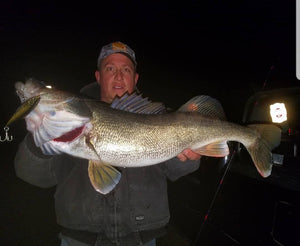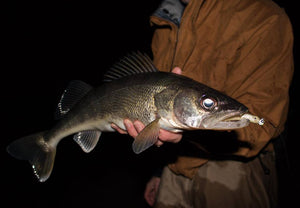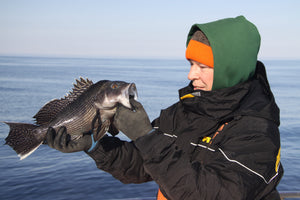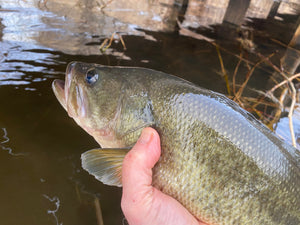Prime Time Bulldogs

Capt. Joe Calandra is no stranger to big blackfish, and bottom fish of all species for that matter, from NY to Alaska!
In case you haven’t noticed by the calendar, our fall blackfish season is already at its mid-point. On the bright side November is prime time for bulldogs, so if you’ve gotten off to a late start at least you are heading out when keepers and trophies are a distinct possibility. The Long Island Sound fall blackfish season runs through December 9 and allows anglers to keep three fish per day while the New York Bight fall blackfish season extends through December 22 with a four-fish daily limit. Sixteen inches is the minimum size in both regions for the tasty crab crushers that thrive in the company of nasty bottom structure.
While the action from this point forward will gradually shift out to deeper and deeper water – improving the odds of connecting with bigger and white chins - there’s still time between now and Thanksgiving to catch these battlers from shore, jetties, inshore wrecks and boulder fields. With thought in mind, here’s a couple of trophy ‘tog tips to help you put extra fillets in the freezer to enjoy over the winter months as tasty chowders, deep-fried nuggets, blackened main courses and, of course, paired with your favorite pasta.
 Even as blackfish move to deeper waters offshore, a 1- to 2.5-ounce blackfish jig can produce impressive results. OutdoorTom.com photo.
Even as blackfish move to deeper waters offshore, a 1- to 2.5-ounce blackfish jig can produce impressive results. OutdoorTom.com photo.
The Best Hook?
Going back a few years, most anglers using the standard single-or double-hook bottom rigs for blackfish favored the Virginia style for tempting ‘tog. While these remain popular today, there are more efficient choices available. We recommend octopus-style hooks, with 3/0 and 4/0 sizes the most popular here at the shop.
Of course, where you fish and the size of the ‘tog expected come into play with hook sizes. For shore fishing, working inlet jetties, and shallow water bottom-bouncing, a size 2/0 or 3/0 octopus-style hook is ideal. These fit in a lot of mouths - ensuring plenty of action – and they’re strong enough to deck most any blackfish you’ll hook in water depths of 40 feet or less.
For inshore wreck fishing, working boulder fields and action over serious mussel beds, size 3/0 to 4/0 octopus-style hooks are a better choice. These larger sizes stand-up to the beating they’ll endure in the abrasive environments where adult blackfish thrive. They also pair well with medium to large green crab halves and even whole “greenies” too large for pesky shorts that might gobble-up smaller baits before potential trophy fish get a chance to bite. Additionally, these hooks easily penetrate the tough lips of double-digit bulldogs, an important point this time of year. We love these sizes in the octopus format for fishing at Orient Point, Plum and Fishers islands and, for those able to make the run, boulder fields along the Connecticut coast.
If a trophy tog is your goal, Jigging World’s single hook blackfish rig in the 4/0 and 5/0 size is certainly worth checking. They also make a Snafu Rig that has produced impressive results. This rig is favored by some blackfish “sharpies” when working true bulldog heavens. It’s designed to place two hooks in the same crab bait and works really well with the extra-large green crabs as the season draws to a close.
Sticking Points
Hook aren’t the only thing that’s changed in the blackfishing world over the past decade, of course. Fishing rods are more sensitive (especially custom designed variety), reels have smoother drags and more power, and lines have progressed from stretchy monofilament to thin-diameter, high-sensitivity, low-stretch braids than need less weight to get to the bottom despite their superior breaking strength.
Indeed, it is good to be a tautog fan these days as far as tackle is concerned, but all this upgrading means you’ll need to make a few adjustments to your blackfish routine. That’s especially so when it comes to setting the hook. The rule used call for a quick, sharp and powerful lift of the rod to overcome monofilament line stretch and assure your hook point penetrates the tough mouth of a keeper blackfish. These days, a softer touch can provide an edge.
Since lines and rods are so sensitive now, you can better feel the difference between a “peck” and a “pick-up” at the end of the Thus, it possible to be more selective as to when you’ll set the hook. Keep a finger to the line, fish through lighter taps, and feel for a slightly more substantial tug. That point, slowly lift your rod tip several inches until the rod takes on a bit of set, indicating something decent has your bait. From there, a sharp, upward sweep to the rod overhead should both bury the barb and get your fish headed upward and away from bottom snags.
 November is prime time for bulldog blackfish. This 15.5-pound brute was caught aboard Capt. Rich Jensen’s Nancy Ann Charters out of Orient Point, NY. Photo by Capt. Jerry McGrath.
November is prime time for bulldog blackfish. This 15.5-pound brute was caught aboard Capt. Rich Jensen’s Nancy Ann Charters out of Orient Point, NY. Photo by Capt. Jerry McGrath.
Cover More Water
Another tip that can really help increase your scores with quality ‘tog is to keep on the move. In today’s high pressure fishing world, it’s important to add a few more hot spots to your grid so you won’t be overworking any one honey hole. Try to sample at least one or two new spots each time out, even if for just an hour. The more productive pieces you accumulate, the longer you can let your prime spots rest and reload.
True, it can be hard to lay off some of the better spots if you get into some impressive fish or feel the need to limit out with your crew, but by not over-pressuring any one piece you should find reliably solid action right through the end of the season. Taking this all a step further, tide permitting you might want to save your best spot for last. That should allow you to put a few keepers on ice before ending the day on a strong note while further degrading prize drops.
CRAWL THAT JIG
There’s no doubt jig fishing for blackfish requires a bit more skill than bait-fishing as water depth increases. Still, today’s braided lines and super-sensitive gear make it possible to hook-up in water depths of 50- to 60-feet or more. That means you should be able to score with this technique right through the end of the fall season given some relatively mild weather.
One key to success with jigging ‘tog at this time of year is to really slow down your presentation. Get that jig to the bottom and simply try to keep it in place for the first couple of minutes. If there’s no response to this, try s-l-o-w-l-y dragging it across the bottom. You want to move the jig lightly, feeling it scrape across the sea floor as you meticulously probe inch-by-inch to bump it against any structure you might feel. Once you have probed the perimeter of the boat, you can also try tossing a jig up-current and working it back by reeling just fast enough to keep slack out of the line. Next, work down-current by getting the jig to the bottom and then constantly lifting up and letting out a few inches of line to let the lure settle back down. As with bait-fishing using current gear, your hook-set should be deliberate in response to the rod lightly loading up. Break out the jigs when working mildly rocky bottom or boulder fields but avoid using them around serious wrecks. It's easy to bounce a jig free of rocky snags but you aren't likely to get it back if it’s set in a wooden wreck.
Be sure to keep your bait to a reasonable size when jigging, too. While whole crab offerings work great on a bottom or snafu rig when weighted with six to ten ounces of lead, the 1- to 2.5-ounce blackfish jigs that perform best lift too easily off the bottom with large halves or whole green crabs. Used during slack water at the very beginning or end of a tide, though, they can produce some outstanding results.
There’s no doubt blackfishing this time of year can be challenging in terms of finding the fish, mastering the techniques and running out to water deep enough to hold some lunkers. Should you need any help, simply stop by the shop and we’ll help you dial in on the game. Consider, also, a trip aboard White Water Charters to fill your limit, sharpen your skills - and possibly hook the biggest bulldog you’ve ever seen.
- Bryce Poyer






